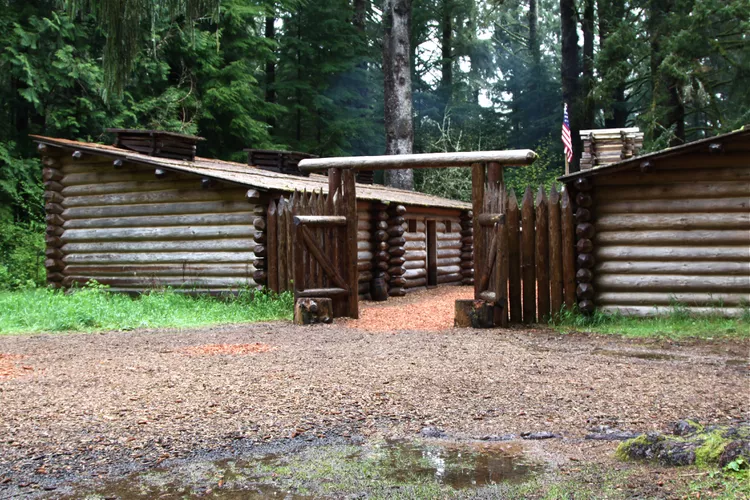The Columbia River, which widens before emptying into the Pacific Ocean, serves as the border between Oregon and Washington at the coast. The Lewis and Clark Expedition established Fort Clatsop, their winter quarters, near present-day Astoria, Oregon. During that winter, Corps members explored places on both sides of the river, traveling as far south as Seaside and as far north as Long Beach.
What Lewis & Clark Experienced
The Lewis and Clark Expedition arrived at Grays Bay on November 7, 1805, thrilled to view what they believed to be the Pacific Ocean. However, a miserable three-week rainstorm halted further travel, leaving them stuck at “Dismal Nitch” for six days. Consequently, they established what they called “Station Camp” on November 15, remaining there for ten days. Their first glimpse of the actual Pacific came on November 18, when they hiked over the hill at Cape Disappointment to view a wild and inhospitable coast.
On November 24, by a vote of the entire Corps including Sacagawea and York, they decided to create their winter camp on the Oregon side of the river. Choosing a site based on the availability of elk and river access to the ocean, the Corps constructed their winter quarters, naming their settlement “Fort Clatsop” in honor of the friendly local people. Fort building commenced on December 9, 1805.
The entire winter was wet and miserable for the Corps. In addition to resting and refreshing their supplies, Expedition members dedicated their time to exploring the surrounding region. Their hope of encountering a European trading ship remained unfulfilled, and the Lewis and Clark and the Corps of Discovery stayed at Fort Clatsop until March 23, 1806.
Since Lewis & Clark
Astoria, Oregon, founded just a few years after the Corps’ 1805/1806 winter at Fort Clatsop, became the first permanent US settlement on the Pacific Coast. Over the years, the lands at and around the mouth of the Columbia River have attracted people for various reasons, starting with the fur trade. Subsequently, fishing, transportation, tourism, and military installations have emerged as major draws to the region.
What You Can See and Do
Lewis and Clark National Historical Park features 12 different sites across the states of Oregon and Washington. The noteworthy sites to visit in the park include the Lewis and Clark National Historical Park Interpretive Center in Cape Disappointment State Park near Ilwaco, Washington, and the Fort Clatsop Visitor Center near Astoria, Oregon. Both attractions are highly recommended stops along the entire Lewis and Clark Trail.
- Dismal Nitch (Washington) – Today, this land has been conserved, with a nearby portion serving as a roadside rest area. The Dismal Nitch site offers wonderful views of the Columbia River, local wildlife, and the Astoria-Megler Bridge.
- Station Camp (Washington) – Once freed from the “dismal nitch,” the Lewis and Clark Expedition found a better campsite, staying from November 15 to 25, 1805. They used this site, called “Station Camp,” as a base to explore the area and determine their next steps. The Station Campsite, an important archaeological site, is currently under development as a park and interpretive attraction.
- Cape Disappointment State Park (Washington) – Situated at the mouth of the Columbia River, Ilwaco, Washington, and Cape Disappointment State Park mark where Lewis and Clark and The Corps of Discovery finally reached their goal – the Pacific Ocean. The Lewis and Clark National Historical Park Interpretive Center tells their story through exhibits, artifacts, murals, and photographs that correspond to expedition journal entries. Additional attractions at Cape Disappointment State Park and its surroundings include Fort Canby, the North Head Lighthouse, the Colbert House Museum, Fort Columbia Interpretive Center, and Fort Columbia Commanding Officer’s House Museum. Visitors can enjoy camping, boating, and beachcombing.
- Fort Clatsop Replica & Visitor Center (Oregon) – The Corps of Discovery built Fort Clatsop, their winter quarters, near modern-day Astoria, Oregon. Although the original structure no longer exists, a replica was created using the dimensions from Clark’s journal. Visitors can tour the fort, witness living reenactments of the Corps’ daily life, hike or paddle to Netul Landing, and view replica dugouts at Canoe Landing. Fascinating exhibits and artifacts are available at the Fort Clatsop Visitor Center, alongside two engaging films.
- Fort to Sea Trail (Oregon) – Spanning 6.5 miles, the Fort to Sea Trail connects Fort Clatsop to Oregon’s Sunset Beach State Recreation Area. The path meanders through dense rainforest and wetlands to the Pacific Ocean, retracing the same terrain that the Corps of Discovery traversed during their winter explorations.
- Ecola State Park (Oregon) – After trading with a local tribe for blubber from a beached whale, several Corps members sought to see the whale remains themselves and to acquire more blubber. This historic site lies within Ecola State Park, which bears the name of Ecola Creek, named by Clark. The park features a 2.5-mile Clatsop Loop interpretive trail, echoing the challenging route used by Clark, Sacagawea, and other Expedition members. Activities at Ecola State Park include surfing, picnicking, lighthouse viewing, walk-in camping, and beach exploring. This scenic stretch of the Oregon Coast is located just north of Cannon Beach.
- The Salt Works (Oregon) – Found in Seaside, Oregon, The Salt Works is part of the Lewis and Clark National Historical Park. Several Corps members camped at this site for most of January and February 1806. They constructed a furnace to produce salt, which was vital for food preservation and seasoning. The well-preserved site features excellent interpretive signage and is open to visitors year-round.





